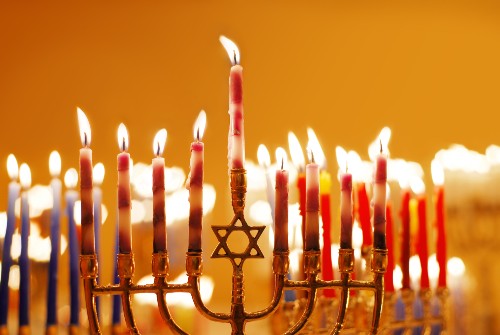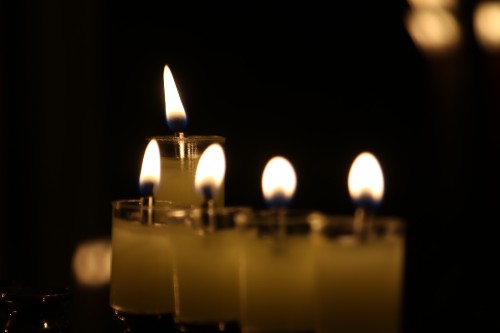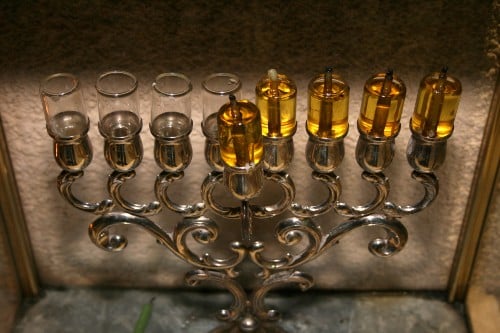Who Must Light?
Every Jewish person must be sure to light Chanukah candles. Even a needy person who relies on charity must sell belongings or collect money in order to be able to light. In such a case, however, one should not collect more than necessary for one candle per night. If a destitute person has enough money to buy as many lights as the number of nights, he still should only light one per night as lighting more will ultimately require him to beg in the future. Nowadays, since candles and oils are cheap, even needy people may light additional lights each night if they feel they have the means.
Do Women Light?
There are different practices regarding whether women who live with men, like a father or a brother, light their own candles. A wife does not light unless her husband isn’t going to be lighting at home. In Israel, where Chanukah lights are lit outside, the practice is that unmarried girls don’t light; in places where Chanukah lights are kindled indoors, many have the practice that girls also light. From a legal perspective, this would seem to be preferable as women and girls were not only involved in the miracle, they were an integral key part of it.
How Many Candles to Light
It is preferable that everyone light for themselves and not fulfill their obligation by relying on another person lighting for them. The most preferable method of lighting is to add an additional light each night of Chanukah, i.e., from one on the first night to eight on the last night.
The Sephardic practice is if the lights are kindled in this most preferable manner, which is called “mehadrin min hamehadrin,” then only one set of lights should be kindled per household. This is in order to allow it to be completely clear how many lights have been kindled. The Ashkenazic practice is for multiple sets of lights should be kindled. In such a case, care must be given to ensure that the different sets of lights can be differentiated from one another.

For the first night or two, we allow two people to light using the same menorah as there would still be a distinct difference between the two sets of lights; one should not do this later on in Chanukah.
If one must choose between lighting the optimum number of lights each night or enabling everyone to light a single light each night, then everyone should light one light.
The number of candles lit must correspond to the number of the night (e.g., five candles on night five), otherwise only one light should be lit.
If the standard of “mehadrin min hamehadrin” cannot be met, even Sephardim revert to the standard of “mehadrin,” in which each member of the household lights a single light.
The Fuel and Wicks
Any kind of fuel and wicks may be used for Chanukah lights. It is preferable to use a fuel and wicks that will burn nicely. It is especially preferable to use olive oil as a reminder of the Chanukah miracle. Some try to use the olive oil that is most similar to that which was used in the Temple, i.e., virgin olive oil, if possible with a low acidity level.

One should not light in a vessel that will become black and smoky, such as clay or uncoated ceramic. If one did light in such a vessel, it should not be used a second time because the vessel is already unappealing.
Wicks can be reused as many times as they will still light and burn well. Once the wicks have been used for the purpose of a mitzvah, scrupulous people are particular not to throw them out; rather, they instead burn them. Some save the wicks to be burned with the chometz before Pesach, in order to use them again for another mitzvah.
Where to Light
For centuries there has been a good deal of discussion as to the best location for kindling the Chanukah lights. There are two essential elements as to where one must light: (1) one must light in a way that facilitates pirsumei nisa (publicizing the miracle) to others (this is valid even if nobody else ends up seeing the candles); (2) one must light in a way that makes it clear that the candles may belong to the one who lit them.
The Brisker Rav maintained that one should light at the entrance to the courtyard; Rav Shlomo Zalman Auerbach maintained that if the door to the home can be seen from the street, then one should light by the door of the house; The Chazon Ish maintained that one should light at the door of the house, though the door of a porch that faces the street is preferable.
Apartment buildings are a relatively new phenomenon with regard to the question as to where to light, and the rulings differ. If one has a porch or balcony that overlooks the street and is not more than 20 cubits high (between 33 and 39 feet), then one may light at the door to this porch or balcony. According to the opinion of the Chazon Ish, it would seem that one can light at the door of his apartment that opens to a communal hallway or stairwell.
According to the Brisker Rav and Rav Shlomo Zalman Auerbach one should light at the entrance to the building as long as there aren’t apartments that open to the entrance area. If there are apartments that open directly to the entrance, those should light at the entrance while the apartments that open up to a stairwell are considered like “hadar b’aliya” (one who lives in an attic); someone who lives in an attic should light by a window.
Outside of Israel, the prevalent practice is to light inside, by a window that can be seen from the street. Many Chasidim light inside by a doorway (generally to the dining room). In most yeshivot, the students light in the dining room.
Regardless of where one lights, one must ensure that the lights can potentially be seen by someone else and that the lights appear to belong to the one who is lighting.
If one lives in a residence that has two or more doors, giving the impression that there are two or more separate dwellings, he should then light near each of those doors.
When one lights at a doorway, the menorah should be placed on the left side, opposite the mezuzah, so that one will be “surrounded by mitzvos.” If there is no mezuzah (because there isn’t a proper doorway), the menorah should then be placed on the right, where a mezuzah would normally be. The menorah must be placed in close proximity to the doorway (within a few inches).
Setting Up and Lighting the Menorah
One should set up the menorah by putting the first night’s light in the rightmost spot. Each succeeding night, we add another light to its left. When we light, we start with the leftmost light (which will always be the newest light). This is the traditional way of lighting but there are differing opinions as to how exactly to set up and in what order to light the menorah. One who has a different custom should continue to adhere to that practice.

On the first night, we recite three brachot before lighting the menorah: lehadlik ner shel Chanukah (on the mitzvah of lighting), she’asah nisim (for the miracle) and shehechiyanu (for reaching this occasion). From the second night on, we only recite the first two blessings before lighting.
If one forgot to recite shehechiyanu, or if he somehow didn’t light on the first night, he should recite shehechiyanu when lighting the first time afterward.
If one didn’t light and won’t be able to, and he also will not be able to have someone else light on his behalf, that person should recite she’asah nisim if and when he sees someone else’s menorah. If this happens on the first night, he should also recite shehechiyanu.
After lighting the Chanukah candles, we recite the paragraph of haneiros halalu (“These lights…”).
When to Light
Chanukah candles should be at nightfall (tzeis hakochavim – when the stars appear). There are opinions that maintain that Chanukah lights should be kindled at shkiya (sunset). Accordingly, many contemporary authorities calculated intermediate times to light in order to accommodate all the opinions.
Chanukah candles should be lit within a half hour of nightfall. This is because in previous generations there was virtually no more traffic in the streets by a half hour after nightfall. Nowadays, since there is usually traffic outside until much later, there are those authorities who are lenient to allow lighting later.
One who is lighting inside may light as long as there is still someone around to see the Chanukah lights (and as long as it is still night).
There must be sufficient fuel to last for a half hour. Regardless of when one lights, there must be enough fuel for the lights to burn at least half an hour past nightfall (or sunset according to the opinion of the Gra). If the lights are still burning beyond this half hour, one may extinguish them, though there are those whose practice is not to extinguish them no matter how long they burn.
Placing the Menorah
The most important part of the Chanukah menorah is the lighting. Candles must therefore be lit in a place that is fit for doing so. They must be lit in the place where they are to remain. Moving the Chanukah candles after they have been lit is tantamount to extinguishing them. One may not even pick up and hold the Chanukah lights in a stationary position.
The menorah must be lit in such a manner that it can remain lit for the entire time that it needs to burn. If a candle is extinguished before a half hour, it does not have to be re-lit provided that it was originally lit in such a way that it should have lasted. If it was lit in such a way that it wasn’t likely to last a full half hour, such as if it was lit in a windy location, then it must be re-lit. The bracha must also be repeated if there was an interruption between when the bracha was originally recited and when the menorah was re-lit.
Some are careful to re-light lights that go out within this half hour even when they are not obligated to.
Since the act of lighting is the mitzvah, and not anything done subsequently, there is no reason to add more oil later in order to enable the lights to last longer (provided that there is already sufficient fuel for a half hour).
The Shamash
We are not permitted to light any of the Chanukah candles from any of the other Chanukah candles, since it is forbidden to derive benefit from the Chanukah candles. Therefore, we light an extra candle called a shamash, which we use to light the others. The shamash should be lit in a way that makes clear that it is separate from the rest of the Chanukah candles. There should be a shamash for each menorah, not one for all of them collectively. A shamash should be lit even in a place with bright electric lighting.
Other
Children of educational age (perhaps as young as three but definitely by the age of nine) should light Chanukah candles of their own. (This refers to the practice of Ashkenazim in which all members of the household light their own menorah.)
Those whose jobs do not enable them to take off time to light Chanukah lights at the appropriate time may light when they get home.
If a single girl comes from a home that is particular that girls don’t light, then she should not light even if she is away from home. She should join together with someone else’s lighting. Ideally, this should be where she is sleeping but she would fulfill her obligation even with someone whom she is just visiting.
Adapted from Hilchos U’minhagei Chanuka by Rabbi Y. Dov Krakowski with permission from our partner OU Kosher.





